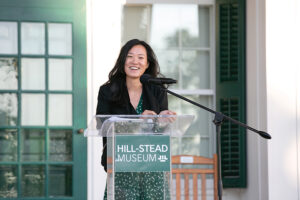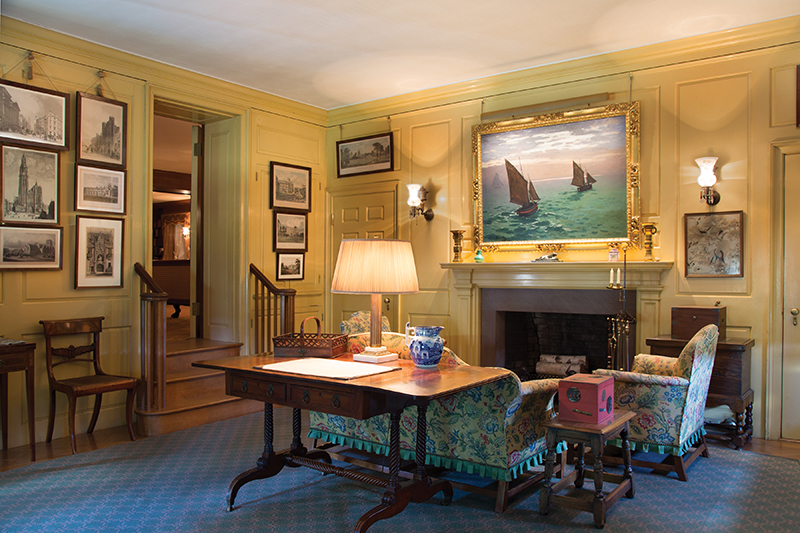
Image Credits: Caryn B. Davis Photography (morning room). Courtesy of Hill-Stead Museum (dancing on the lawn). Courtesy of The Sunken Garden Poetry Festival (garden).
Just at the southern bend of the Farmington River, high on a hill above Miss Porter’s School and the grave of William Gillette, poets are gathering. They walk onto the broad summer meadows of the Hill-Stead Museum for the nationally acclaimed Sunken Garden Poetry Festival: lounging in front of the tall white pillars of the Colonial Revival mansion, wandering through manicured hedges, and peeking inside at paintings by great Impressionists like Claude Monet and Edgar Degas. As the sun sets, lawn chairs and blankets cover the west lawn, and voices ring into the swallow-haunted twilight.
Margaret Gibson recently served as Poet Laureate of Connecticut and has recited her poetry at the Hill-Stead many times over the last three decades. “Whether reading to an audience in the Sunken Garden itself or on the west lawn, you are close enough to look into the faces of the audience as you read and also to glance beyond the audience into the blue distance of the Farmington Valley hills,” she says. “Reading poems at the Hill-Stead adds to the sense of intimacy with people, an uplifting sense that words and human artistry have a place in this world—which is itself, at its best, both naturally and culturally creative.”
The Hill-Stead is an avatar of that human artistry in the Farmington River Valley. Built on 152 acres of gorgeous meadows, gardens, forests, and a working farm, architect Theodate Pope Riddle’s 1901 estate is one of those rare museums that displays a collection of art in situ. “I was the curator at MoMA for a long time, and have traveled to museums all over the world, and there are very few like Hill-Stead,” says Executive Director and CEO Anna Swinbourne. “These paintings were meant to be appreciated in a residential setting, in a home, and that’s what we have.”
The uniquely designed country home set amidst Beatrix Farrand gardens gives museum-goers a different experience of the masterpieces inside, perhaps more authentic and certainly more intimate. And that setting and experience is no accident. “It was specifically designed that way by the family,” says Swinbourne. “If you want well-being you need to cultivate the life of the mind, of human culture, inside, while having a direct relationship with nature outside.” The Hill-Stead’s new rotating exhibition space will also tell stories from history through a broad, dynamic schedule of programming—decorative arts, fashion, fine arts, and more.

Headline poet Jenny Xie at the 2021 Sunken Garden Poetry Festival. Image Credits: IRIS Photography
This blended experience at the Hill-Stead—of natural and built environments, of agriculture and artistic culture, of poetry and history—exemplifies the broader values of the Farmington River Valley. Swinbourne calls this the region’s metaculture. “The metaculture of any collective body is a combination of its ethos, its essence, and its way of being,” she says. “And that is not just who we are in the day to day, but what we aspire to.”
From the colorful sculptures of Peter Greenwood’s glass blowing studio in Riverton by the Massachusetts border, to the 18th century houses of the Windsor Historical Society by the Connecticut River, the Farmington winds down past great art, great music, great food, and great architecture. No one art dominates the scene, with options for all interests and pursuits.
Just traveling downstream along the river from the Hill-Stead, you pass the performance venue of the Talcott Mountain Collective, the craft beers of Hopmeadow Brewing Company, and Theodate Pope Riddle’s architectural masterpiece of Avon Old Farms School. Turning at the mighty Pinchot Sycamore, you’ll find Rosedale Farm and Winery, a fifth-generation farm that continues to deliver produce, flowers, and delicious estate-grown wines to the people of the valley. Heading toward Granby you reach the Simsbury Meadows Performing Arts Center, where on summer nights concert-goers listen to the Hartford Symphony under the stars. North and west up the Salmon Brook watershed, you could visit the headquarters of the Simsbury Light Opera Company, browse the incredible collection of historical buildings and artifacts at the Salmon Brook Historical Society, taste the latest vintages at Brignole Vineyard, or sample pale ales at Maple View Farm.

Installation view of the exhibition A Perfect Perch: The Architect’s Chair in 2022 in collaboration with Centerbrook Architects and Planners. Image credit: Derek Hayn
On just such a journey, my wife and I arrive at the fine French-American restaurant, Present Company, located in an old Tariffville mill far from the state’s population centers, where the river bends through the Metacomet Ridge. Cooks bustle around an open kitchen in the warm soft light of the homelike atmosphere. We order seared cotechino sausage with espresso mustard, salted caramel glazed squab breast in soft pretzel puree, duo of rabbit cacciatore with grilled polenta terrine, and much more. Chef de cuisine Ethan Czarneski stops by each table. “It’s an underrated culture out here,” he tells us. “We have people who come in every single week, 52 weeks a year.” He waves at some guests just arriving to the packed dining room. “And they are willing to dive into unfamiliar environments. It leads to great relationships, to collaboration and respect.”
Many of those people in the restaurant, including Czarneski himself, are young and adventurous. And throughout the valley, we find young people who exhibit an active and enthusiastic pursuit of culture, fueled by education in the arts and a willingness to learn new things. Czarneski pursued an undergraduate degree at Central Connecticut State University and simultaneously worked his way up from dishwasher to chef de cuisine, finding his passion in the thriving food culture in the state.
Often, people find their artistic passion outside traditional education at places like libraries, farms, and, of course, museums. “Coming to Connecticut I was afraid of homogeneity,” says Anna Swinbourne. “But I discovered that there is incredible diversity here, combined with the embarrassment of riches in education and access.”
There are places that inspire creativity, like the Open Art Studio at Avon Free Public Library, and places to learn from professional working artists, like the Farmington Valley Arts Center. There are places for young artists to perform their work, like poetry night at the wood-paneled Crown and Hammer Pub in Collinsville, and places for young artists to display their work, like the old Freight House in the Windsor Art Center. “There is always something new and interesting you can learn here,” says Swinbourne. “It has become a cultural and educational hub.”
Encountering the arts locally, amidst natural beauty, and in context, the way you do along the Farmington River at the Hill-Stead, can often lead to a greater appreciation. “You might suddenly see the pattern between the break in the window glass and the irregular geometry of the tree through that window,” says Swinbourne. “It can be spontaneous, people can walk away from it enriched and transformed. And it is not a one-way street—I come away feeling energized every day.”

